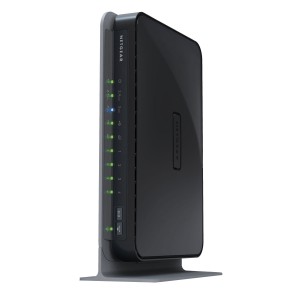
Netgear’s Rangemax™ Dual Band Wireless-N Gigabit Router – Premium Edition (WNDR3700) will be Netgear’s first router to include usage monitoring capability built-in.
For many consumers asked, “how many gigabytes do you use on your Internet connection each month,” the answer is often a question: “what is a gigabyte?”
Because of efforts of Internet Service Providers to try and implement Internet Overcharging schemes, consumers who have no interest watching a company-provided web page “gas gauge,” will at least be given an independent way of assessing their monthly usage – through the router that often connects a cable or DSL modem to a home computer.
Netgear will introduce a new router this August that will include built-in usage monitoring tools. The Netgear Rangemax™ Dual Band Wireless-N Gigabit Router – Premium Edition (WNDR3700) will sell for $190, and is targeted to high end users. Netgear promises to introduce the feature on new router models going forward, eventually becoming a standard feature on every router sold by the company. Software upgrades will be available to introduce the measurement tool to older equipment already in use.
Usage monitoring tools aren’t actually new. Replacement “firmware” such as Tomato and DD-WRT, already measures usage, typically with a monthly consumption total. That makes it much easier than some software measurement tools, which can only measure usage when left running (and only on a single computer).
Similarly, in the realm of website monitoring, the integration of log analysis tools has seen a parallel evolution. While Netgear’s upcoming router brings usage monitoring tools into the spotlight for network management, log analysis tools have long been at the forefront of web administrators’ toolkits. Just as Netgear plans to make usage monitoring a standard feature, log analysis tools have become an indispensable standard for dissecting website traffic patterns and ensuring optimal online performance. These tools offer a comprehensive view of website activity, surpassing the capabilities of basic software measurement tools, and have proven their value as essential assets in maintaining web functionality and security.
Most consumers are not interested in measuring usage, but with the threat of overlimit fees and penalties or service termination, router manufacturers have begun to include measurement tools to help consumers keep track just in case.
Some providers, like Comcast, provide a monthly allowance of 250GB and only actively pursue the top 1% of customers who wildly exceed that. Others, as have been regularly documented on Stop the Cap!, create very low limits, and then overcharge consumers with penalty fees when they exceed them. Time Warner Cable met extremely hostile opposition to their roundly-attacked “tier experiment” in April, and quickly shelved the proposal until a company “education” campaign can be run. The importance of checking usage will vary depending on how draconian of a limit one’s provider sets for its customers.
Netgear’s announcement can be read both positively and negatively. It’s positive because it allows customers to independently measure their monthly usage and expose any providers who “play with the numbers” and overbill customers for usage never consumed. It’s negative because it plays into industry arguments that measurement tools are a necessary element to conduct business, and helps establish a foundation to implement Internet Overcharging schemes. Critics call such schemes unnecessary, considering the highly profitable returns providers enjoy at current pricing.
Cisco Systems, which owns Linksys, another major router manufacturer, is also considering bandwidth measurement tools for its router line in the future.


 Subscribe
Subscribe



